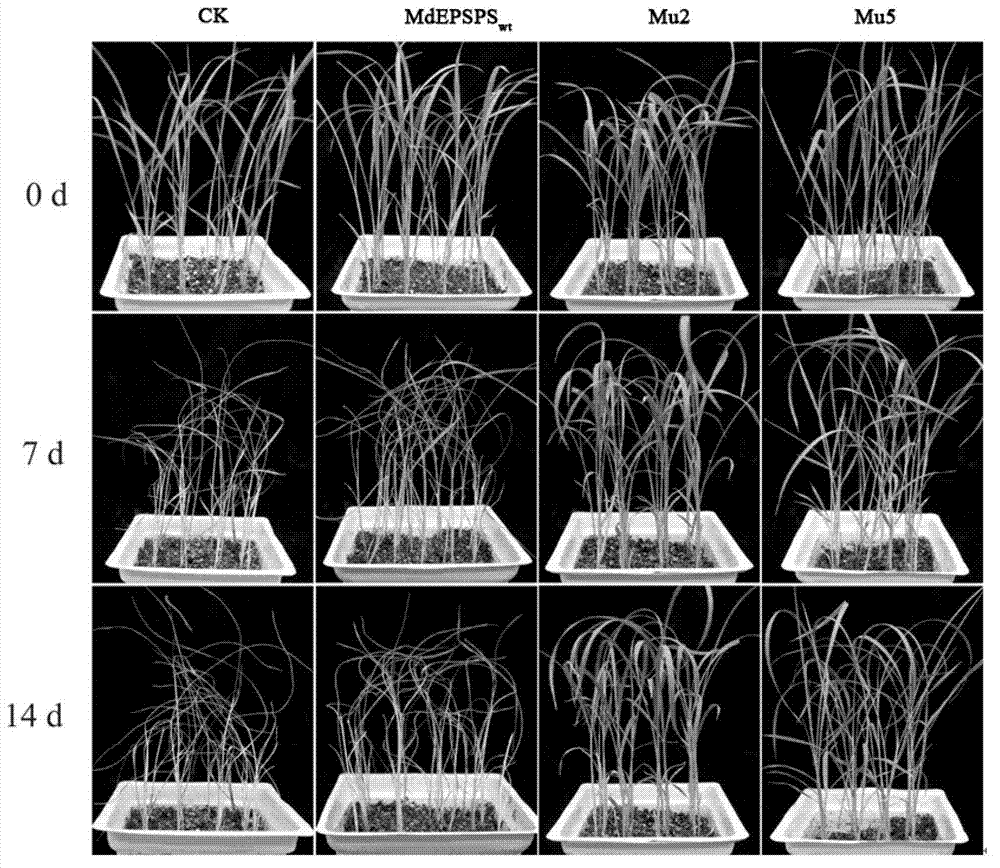EPSP (5-enolpyruvyl shikimate-3-phosphate) synthase multisite mutant from Malus domestica, and coding gene and application of mutant
A technology of EPSP synthase and multi-site mutation, which is applied to EPSP synthase multi-site mutants derived from apples and their coding genes and application fields, can solve disadvantages and other problems, and achieve improved resistance and strong affinity Sexuality, the effect of high glyphosate resistance
- Summary
- Abstract
- Description
- Claims
- Application Information
AI Technical Summary
Problems solved by technology
Method used
Image
Examples
Embodiment 1
[0018] Example 1 DNA molecular rearrangement (DNA Shuffling) of EPSP synthase gene
[0019] 1.1 Synthesis of glyphosate-resistant herbicide-resistant gene MDEPSPS derived from apple
[0020] The EPSP synthase gene MdEPSPS from apple was synthesized by gene synthesis method (Nucleic Acids Research, 2004, 32, e98). The sequences of 22 pairs of primers were designed as follows:
[0021] 1.MdEPSPS-1:Tm=54,60mer
[0022] ATGCCGGAGATTGTGCTGCAACCCATCCAAGAAATCTCGGGCACCATAAAGTTGCCGGGT
[0023] 2.MdEPSPS-2:Tm=54,60mer
[0024] CAGCAGAATTCGATTCGACAACGACTTGGAACCCGGCAACTTTATGGTGCCCGAGATTTC
[0025] 3.MdEPSPS-3:Tm=54,60mer
[0026] TCCAAGTCGTTGTCGAATCGAATTCTGCTGATTGCTGCCTCTCTCTGAGGGAACAACTGTT
[0027] 4.MdEPSPS-4:Tm=54,60mer
[0028] AATATCTTCACTATTCTAACAAGTTGTCAACAACAGTTGTTCCCTCAGAGAGAGCAGCAAT
[0029] 5.MdEPSPS-5:Tm=54,60mer
[0030] GTTGACAACTTGTTAGATAGTGAAGATATTCATTATATGCTTGGTGCATTGAAAACCCTT
[0031] 6.MdEPSPS-6:Tm=54,60mer
[0032] GTTTTCCTTGTCCTTCTTCAACATCCAGCCCAAGGGTTTTCAAT...
Embodiment 2
[0119] Example 2 High glyphosate resistance EPSP synthase screening
[0120] The above-mentioned recovered and rearranged EPSP synthase gene fragment was digested with BamH I and Sac I, and then constructed into the prokaryotic expression vector pG251 (CN1338515) between the promoter and the t1t2 terminator, which carries the ampicillin resistance gene. Transform Escherichia coli strain DH5α by electroporation to obtain mutant expression library with a capacity of 10 8 , and then use a large number of plasmid extraction kits (Omega, USA) for plasmid extraction.
[0121] Take 1 μl of a large amount of extracted plasmid and transfer it into Escherichia coli ER2799 (NEB Company) and spread it on an M9 plate containing 50mM glyphosate for 48 hours. Three colonies were found to grow well. These three colonies were inoculated on the M9 plate containing 50mM and 80mM glyphosate, and it was found that only one clone could grow on the M9 plate containing 80mM glyphosate. The plasmid ...
Embodiment 3
[0122] The EPSP expression of embodiment 3 high glyphosate resistance
[0123] 3.1 Sequence analysis of DNA fragments highly tolerant to glyphosate
[0124] The highly tolerant glyphosate plasmid pMdEPSPS obtained by screening in Example 2 was utilized step-by-step sequence determination method mutant Full sequence DNA sequencing. The analysis results showed that the highly glyphosate-resistant mutant contained the following 1 to 8 mutation sites on the same molecule, specifically: mutation site 1 (N63D), which is the 63rd position in the amino acid sequence of EPSP synthase Asparagine is replaced by aspartic acid; mutation site 2 (N86S), that is, asparagine at position 86 is replaced by serine; mutation site 3 (T101A), that is, threonine at position 101 Replaced with alanine; mutation site 4 (A187T), that is, alanine at position 187 was replaced with threonine; mutation site 5 (D230G), that is, aspartic acid at position 230 was replaced Glycine; mutation point 6 (H317R), t...
PUM
 Login to View More
Login to View More Abstract
Description
Claims
Application Information
 Login to View More
Login to View More - Generate Ideas
- Intellectual Property
- Life Sciences
- Materials
- Tech Scout
- Unparalleled Data Quality
- Higher Quality Content
- 60% Fewer Hallucinations
Browse by: Latest US Patents, China's latest patents, Technical Efficacy Thesaurus, Application Domain, Technology Topic, Popular Technical Reports.
© 2025 PatSnap. All rights reserved.Legal|Privacy policy|Modern Slavery Act Transparency Statement|Sitemap|About US| Contact US: help@patsnap.com



